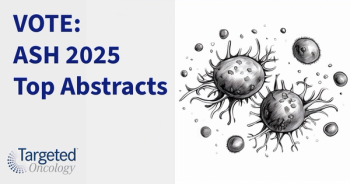
Combination Dabrafenib and Trametinib Beneficial in BRAF-Mutant NSCLC
Combination therapy dabrafenib and trametinib showed positive outcomes in patients with BRAF V600E-mutant NSCLC, according to phase II trial data presented at the 2016 ASCO Annual Meeting.
David Planchard, MD, PhD
Combination therapy dabrafenib (Tafinlar) and trametinib (Mekinist) showed positive outcomes in patients withBRAF V600E-mutant nonsmall cell lung cancer (NSCLC), according to phase II trial data presented at the 2016 ASCO Annual Meeting.1
The study’s findings were also concurrently published inLancet Oncology.2
The investigator assessed objective response rate (ORR) with the combination was 63% (95% CI, 49-75), which lasted for a median duration of 9.0 months (95% CI, 6.9-18.3). When adding those with stable disease for ≥12 weeks, the overall disease control rate was 79% (95% CI, 66-89). The median progression-free survival (PFS) was 9.7 months (95% CI, 6.9-19.6).
In addition to the combination cohort, the study also included a single-agent arm that included 78 previously treated patients with metastaticBRAFV600Emutant NSCLC. In this cohort, the ORR with single-agent dabrafenib was 33% and the median PFS was 5.5 month. Findings from both cohorts of the study have led to breakthrough therapy designations from the FDA for dabrafenib as a single agent and in combination with trametinib.
"Dabrafenib plus trametinib provides an important treatment option for patients withBRAFV600E-mutant NSCLC, with greater clinical activity compared with dabrafenib monotherapy," said lead investigator David Planchard, MD, PhD, from the Department of Cancer Medicine at the Institute Gustav Roussy in Villejuif, France. "The safety profile was manageable and similar to previous experience in melanoma."
In the study, 57 patients were treated with dabrafenib at 150 mg twice daily plus trametinib at 2 mg once daily. Patients in the study had received at least 1 prior line of platinum-based chemotherapy, with 33% having received ≥2 prior regimens. The primary endpoint of the study was ORR by RECIST criteria, with secondary outcome measures focused on PFS, duration of response, overall survival (OS), and safety.
The median age of patients was 64 years and 98% had adenocarcinoma histology. The most common ECOG performance status was 1 (61%). The majority of patients were former or current smokers (72%), 51% were male, and 86% were Caucasian. In the smoking group, 46% of patients had >30 pack years.
After a median follow-up of 11.6 months, 2 patients (4%) had experienced a complete response with the combination by investigator assessment. Overall, 9 patients had stable disease as their best response (16%). At the data cutoff in October 2015, 50% of confirmed responses remained ongoing.
By independent assessment, there were no complete responses and the stable disease rate was 7%. The ORR by independent review remained 63%; however, the disease control rate was 75%. Duration of response was 9 months (95% CI, 5.8-17.6) and the median PFS was 8.6 months (95% CI, 5.2-19.1).
At the time of the analysis, median OS data were immature. The 6-month OS rate was 82%. At the 11.6-month follow-up analysis, 60% of patients remained alive.
"This study confirms a fourth actionable biomarker in NSCLCBRAFV600Eafter EGFR,ALKand ROS-1," said Planchard. "The potential to treat this oncogene gives hope to a very small, underserved patient population."
All grade adverse events (AEs) occurred in 98% of those treated with the combination, and 49% of patients experienced a grade 3/4 AE. Serious AEs were seen in 56% of patients, 35% of which were grade 3/4 in severity. AEs led to dose reductions or discontinuation for 35% and 14% of patients, respectively. Dose interruptions or delays were utilized for 61% of patients. There were 4 fatal AEs.
The most common all-grade AEs observed in the trial were pyrexia (46%), nausea (40%), vomiting (35%), diarrhea (33%), asthenia (32%), decreased appetite (30%), peripheral edema (23%), cough (21%), and rash (21%). The most common serious AEs were pyrexia (16%), anemia (5%), confusional state (4%), decreased appetite (4%), hemoptysis (4%), hypercalcemia (4%), nausea (4%), and squamous cell carcinoma of the skin (4%).
“Nearly all of the patients experienced at least 1 adverse event, and at least half had at least 1 grade 3 adverse event,” Planchard said. “Generally, it was grade 3 adverse events, with few grade 4 or 5 adverse events.”
BRAFalterations are present in approximately 1% to 2% of NSCLC cases. The FDA breakthrough therapy designation for the combination of dabrafenib and trametinib was received July 2015, for patients with BRAFV600E-mutant NSCLC. This designation was based upon earlier results from 33 patients enrolled in the phase II study. The single-agent breakthrough designation was received in January 2014.
The multi-cohort study, which the developer of the combination Novartis called pivotal, continues to enroll participants (NCT01336634). A third cohort is assessing the combination as a frontline therapy for patients withBRAF-mutated NSCLC. This portion of the study has fully accrued 34 patients, with results expected in the near future.
Outside of NSCLC, the combination of dabrafenib and trametinib became the first FDA-approved combination therapy for patients with metastatic melanoma in January 2014. This approval was based on early phase data, with additional trials conducted to support the approval that showed improvements in survival and other key endpoints.
Planchard D, Besse B, Groen HJM, et al. An open-label phase II trial of dabrafenib (D) in combination with trametinib (T) in patients (pts) with previously treated BRAF V600Emutant advanced non-small cell lung cancer (NSCLC; BRF113928).J Clin Oncol.2016;34 (suppl; abstr 107).
Dabrafenib plus trametinib in patients with previously treated BRAFV600E-mutant metastatic non-small cell lung cancer: an open-label, multicentre phase 2 trial [published online June 6, 2016].Lancet Oncol.doi: 10.1016/S1470-2045(16)30146-2.









































